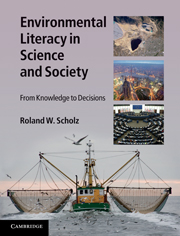Book contents
- Frontmatter
- Contents
- Boxes
- Acknowledgments
- International praise for Environmental Literacy in Science and Society
- Preamble
- Overview: roadmap to environmental literacy
- I Invention of the environment: origins, transdisciplinarity, and theory of science perspectives
- II History of mind of biological knowledge
- III Contributions of psychology
- IV Contributions of sociology
- V Contributions of economics
- VI Contributions of industrial ecology
- VII Beyond disciplines and sciences
- VIII A framework for investigating human–environment systems (HES)
- IX Perspectives for environmental literacy
- Glossary
- References
- Index
VIII - A framework for investigating human–environment systems (HES)
Published online by Cambridge University Press: 05 August 2012
- Frontmatter
- Contents
- Boxes
- Acknowledgments
- International praise for Environmental Literacy in Science and Society
- Preamble
- Overview: roadmap to environmental literacy
- I Invention of the environment: origins, transdisciplinarity, and theory of science perspectives
- II History of mind of biological knowledge
- III Contributions of psychology
- IV Contributions of sociology
- V Contributions of economics
- VI Contributions of industrial ecology
- VII Beyond disciplines and sciences
- VIII A framework for investigating human–environment systems (HES)
- IX Perspectives for environmental literacy
- Glossary
- References
- Index
Summary
Key questions (see key questions 1–3 of the Preamble)
Contributions from transdisciplinarity to environmental literacy
Q1 How can researchers or transdisciplinary groups define, investigate, and access environmental systems that are inextricably related to human systems?
Q2 What rationales and drivers do we find in different human systems? What drivers, dynamics, and interactions are perceived in environmental systems? How can the HES framework help to conceptualize and better understand interacting human and environmental systems?
Q3 How can we draw on the unique value of various disciplines to analyze HES in an interdisciplinary way? What is the role of transdisciplinary processes here?
Information
- Type
- Chapter
- Information
- Environmental Literacy in Science and SocietyFrom Knowledge to Decisions, pp. 405 - 406Publisher: Cambridge University PressPrint publication year: 2011
